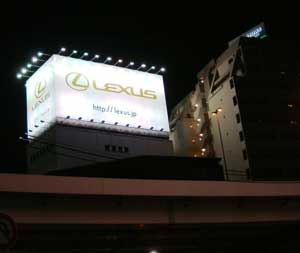They’re big, they’re bold, but few find them beautiful. Billboards are also big business. In 2006, advertisers spent $6.8 billion on outdoor advertising, up 8% from the previous year. About 64% of that is spent on billboards for amusements, insurance, real estate, media and communications, financial, automotive, strip clubs ads, etc. From 2006-2007, outdoor advertising budgets for the new, bright digital versions nearly doubled, and are expected to double again by 2009. (Source: Outdoor Advertising Association of America [OAAA]).
 |
Commercial catastrophe or expression of free speech? Spending on bright digital billboards doubled from 2006-2007. |
Like pop-up ads on the Internet, eyeball captivating billboards do grab attention, which is why advertisers favor them. For example, 29% of people say outdoor advertising caused them to visit a retail store within a week (Arbitron Outdoor Study). Billboards also allow the advertising industry to reach a significant audience – commuters. The average American travels 302 miles a week, spending 15 hours in the car, and drive time is on the increase.
As OAAA notes, unlike TV, radio or print, a billboard can not be turned off or put down. The inability to fast-forward through it gives advertisers more control over consumers. Vendors note that “outdoor advertising is a great way to reach people where they live, work and play. The media creates brand new ad spaces where none existed before.”
Lady Bird Johnson’s campaign to Keep America Beautiful insisted on cleaner, more scenic public spaces. The Highway Beatification Act was passed in 1965, to remove walls “placed by civilization between us and the beauty of our countryside.” Unfortunately, loopholes and lax guidelines have rendered it largely ineffective. An additional 5,000-15,000 new billboards are constructed each year, adding to more than 450,000 existing ones (Congressional Research Service and Scenic America estimates, 1991). Nonconforming billboards are protected unless state and local governments pay to remove them – and taxpayers have already spent more than $250 million to do so. Per mile, the law still allows an astounding 21 billboards on an Interstate, 36 on a rural primary highway, and 106 on urban public highways.
Hawaii, Maine, Alaska and Vermont have banned billboards for decades. In February 2008, Governor Jodi Rell proposed that Connecticut say ‘no’ to billboards along our state highways. Rell issued an executive order, and submitted legislation to stop new billboards from being erected on state-owned property. The bill would also halt renewal of existing contracts, which only net the State $20-60/per year/per billboard. Apparently some lawmakers were torqued that Rell did not consult with them, the billboard industry or DOT, and have proposed another bill to counteract her executive order.
Outdoor advertisers bitterly oppose such controls in the name of free markets, free speech, and negative impacts to the economy. They argue that ““It is not acceptable to use aesthetics to rationalize against the promotion of legal products or the exercise of free expression guaranteed by the First Amendment to the Constitution.”
On the other hand, Scenic America (scenic.org), a non-profit advocacy organization, believes that “Nothing destroys the distinctive character of our communities and the natural beauty of our countryside more rapidly than uncontrolled signs and billboards." They lament the explosion of “visual kudzu” that dominates and pollutes the landscape, and note that billboards force people to live inside a giant, unending commercial.
"...billboards are acts of aggression...against which the public is entitled, as a matter of privacy, to be protected. If a homeowner desires to construct a huge Coca-Cola sign facing his own homestead rather than the public highway, in order to remind him, every time he looks out his window, that the time has come to pause and be refreshed, he certainly should be left free to do so. But if he wants to face the sign toward us, that is something else...."
– William F. Buckley Jr., “The Politics of Beauty, July 1966. |
|

